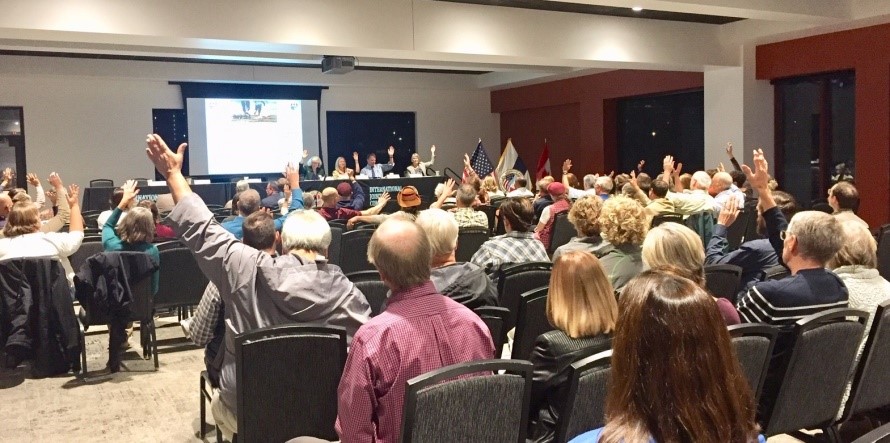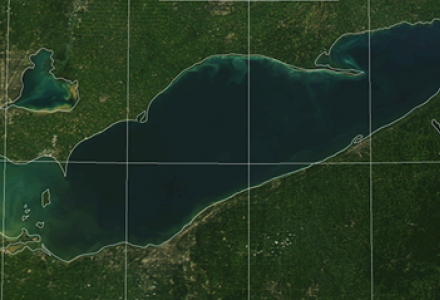In its last round of consultations and public meetings to determine progress under the Great Lakes Water Quality Agreement by Canada and the United States, the IJC heard a consistent message from residents in Thunder Bay, Ontario; Duluth, Minnesota; and Ashland, Wisconsin: Lake Superior is central to who they are as a region, and it is under threat in several ways. What happens to the lake happens to its residents and protecting the health of the entire ecosystem requires urgent action.
Thunder Bay, Ontario
The Commission started its travels on September 23 at Lakehead University in Thunder Bay, where it sponsored a day-long symposium on climate change impacts and adaptation in the Lake Superior basin. Department of Geography Associate Professor Dr. Rob Stewart organized the “Climate Con 2019” symposium. Keynote addresses were given by Dr. Jay Austin, professor at the University of Minnesota at Duluth, on the last century of warming in Lake Superior, and Kelsey Casey Jones of the Weave Collaborative on how residents are coping with climate change. Several Lakehead University professors also presented their findings on the impacts of climate change on Lake Superior, and students presented summaries of their ongoing research.
Austin confirmed that Lake Superior is experiencing the most drastic change in reduced ice cover and warmer average summer water temperatures, up to 1.2 degrees Celsius. The lake’s temperature is projected to rise by up to 5 degrees Celsius by 2070. The 1.2-degree increase has already resulted in significant severe weather events and the appearance of harmful algal blooms along the lake’s south shore.
Lakehead University’s Dr. Adam Cornwell explained that Lake Superior and other mid-continental regions will warm faster. If the average rise in air temperature globally is 1.5 degrees Celsius, for example, the Lake Superior basin will experience a 4-degree C increase in air temperatures.
During the afternoon small group discussions, symposium participants discussed priority topics ranging from the establishment and spread of aquatic invasive species to increased algal blooms as the lake warms. One common theme was the need for governments at all levels to take bold action to protect Lake Superior. Severe storms have caused millions of dollars in damages in the lake’s western region, and are expected to increase in frequency and intensity. Participants said governments should focus on mitigating and preventing infrastructure damage from future storms.
Duluth, Minnesota; and Superior, Wisconsin
Great Lakes researchers, advocates and agency representatives from the Twin Ports region met with IJC Commissioners and staff the next day for an expert roundtable on key water quality issues. The discussion included updates on progress to restore the St. Louis River Area of Concern and the need to develop a framework for long-term monitoring of the river after delisting to ensure continued recovery. Management actions are expected to be complete by 2025. Others said updating remote sensing surveillance systems is essential throughout the Great Lakes to understand how streams and lakes are changing with increased precipitation from climate change.


In the evening public meeting, residents noted the importance of connecting people to their local waters. The St. Louis River Alliance was mentioned as a valuable initiative that connects people to their local waters and encourages awareness and involvement in local water protection efforts. Several people expressed concern about the discontinuation of the Lake Superior Binational Forum due to the elimination of federal funding, saying it provided a valuable opportunity for citizens, agency representatives and others to coordinate protection efforts across Lake Superior. Several meeting participants called for funding to be reinstated to support lakewide communication and coordination. Other needs raised included proactive watershed planning, investigating and controlling toxic mining outflows, adding sulfate as a Chemical of Mutual Concern under Annex 3 of the Great Lakes Water Quality Agreement, prohibiting proposed sulfide mines in Minnesota and Michigan, and preschool through grade 12 curricula focused on water and the Great Lakes.
Ashland, Wisconsin
The IJC’s last stop on its Lake Superior tour was at Northland College, where Peter Annin and Valerie Damstra of the Mary Griggs Burke Center for Freshwater Innovation organized an evening public meeting and day-long briefing on Lake Superior issues. Representatives from the Bad River and Red Cliff Bands of Chippewa, Great Lakes Indian Fish and Wildlife Commission, City of Ashland, Wisconsin, Minnesota environmental agencies and college professors all presented to IJC Commissioners.
Commissioners learned about nearby Chequamegon Bay’s status as one of the most ecologically significant in Lake Superior. The bay boasts wetlands, two self-sustaining sturgeon populations, a large wild rice crop, the Apostle Islands National Lakeshore and the first tribal national park in the U.S. Remediation of contaminants at a Superfund site in Ashland harbor is ongoing, and the city’s 100-year-old sanitary sewers require upgrades to deal with a 35-40 percent increase in precipitation since the mid-1900s, when the infrastructure was built. The area has experienced three 1,000-year storms since 2012 that caused extensive damage, and so funding is needed to mitigate exisiting and prevent future damage. The role of climate change also is believed to be influencing the appearance of harmful algal blooms in Lake Superior starting in 2012.
The presentations were recorded by Wisconsin Public Radio.

The Canadian and US governments’ ranking of Lake Superior as “good and unchanging” was questioned in Ashland as it was by residents in the other Lake Superior communities that the IJC toured. Responding to and preparing for climate change was continually raised as the top concern, followed by aggressive, concrete action to stop nonpoint sources of pollution into the lake. Participants encouraged Commissioners to urge both countries to focus on protection as well as restoration actions. Residents also called on both governments to develop a new Great Lakes Water Quality Agreement that provides an effective framework to deal with 21st century issues and provides the governmental structures, funding, outreach and education necessary for restoring and protecting all of the Great Lakes.

Sally Cole-Misch is the public affairs officer for the IJC’s Great Lakes Regional Office.




